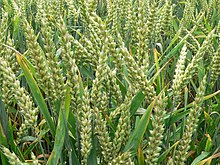Rabi crop

Wheat

Barley
Rabi crops or
rabi harvest are agricultural crops that are sown in winter and harvested in the spring in South Asia.[1] The term is derived from the Arabic word for "spring", which is used in the Indian subcontinent, where it is the spring harvest (also known as the "winter crop").
Contents
1 Etymology
2 Rabi season
3 Common rabi crops
3.1 Cereals
3.2 Fruits
3.3 Legumes / lentils (dal)
3.4 Seed plants
3.5 Vegetables
3.6 Others
4 See also
5 References
6 External links
Etymology
The words 'kharif' and 'rabi' have their origin in Arabic. These came to be used in India with the ascent of the Mughal empire in the Indian subcontinent and have been widely used ever since.
Rabi season
The rabi crops are sown around mid-November, preferably after the monsoon rains are over, and harvesting begins in April/May. The crops are grown either with rainwater that has percolated into the ground, or using irrigation. A good rain in winter spoils the rabi crops but is good for kharif crops.
The major rabi crop in India is wheat, followed by barley, mustard, sesame and peas. Peas are harvested early, as they are ready early: Indian markets are flooded with green peas from January to March, peaking in February.
Many crops are cultivated in both kharif and rabi seasons. The agriculture crops produced in India are seasonal in nature and highly dependent on these two monsoons.[2]
Common rabi crops
Cereals
- barley
- gram
- rapeseeds
- mustard
oat (Avena sativa)
wheat (Triticum aestvium)
Fruits
List as follows:[3]
- almond
- banana
- ber
- date
- grape
- grape fruit
- guava
- kinnow
- lemon
- lime
- mandarin orange
- mangoes
- mulberries
- orange
Legumes / lentils (dal)
chickpea[4]
kulthi[4]
lobia[4]
masoor[4]
mung bean[4]
- pigeon pea
- toria
Urad bean[4]
Seed plants
alfalfa (also known as lucerne, Medicago sativa)
coriander (Coriandrum sativum, L)
cumin (Cuminum cyminum, L)
fenugreek (Trigonella foenumgraecum, L)- linseed
mustard (Brassica juncea L.)
isabgol (Plantago ovata)- sunflower
Vegetables
List as follows:[5][3]
- bean
beetroot (chukunder)
brinjal (baingan)
broccoli (hari gobhi)
cabbage (patta gobhi)
capsicum[5]
carrot (gajar)
cauliflowers (gobhi)
chickpea (also known as gram, Cicer arientinum) (channa)
fenugreek (methi)
garlic (lehsun)
lady finger (bhindi)
lettuce (salad gobhi)
pea (mattar)
onion (Allium cepa, L.) (pyaj)
potato (Solanum tuberosum) (aloo)
radish (mooli)
spinach (palak)
sweet potato (shakargandi)
tomato (Solanum lycopersiucum, L) (tamatar)
turnip (shalgum)
Others
tobacco[3]
See also
Kharif crop
References
^ Balfour, Edward (1885). The Cyclopaedia of India and of Eastern and Southern Asia (3 ed.). London: Bernard Quaritch. p. 331. Archived from the original on 2014-04-15..mw-parser-output cite.citation{font-style:inherit}.mw-parser-output q{quotes:"""""""'""'"}.mw-parser-output code.cs1-code{color:inherit;background:inherit;border:inherit;padding:inherit}.mw-parser-output .cs1-lock-free a{background:url("//upload.wikimedia.org/wikipedia/commons/thumb/6/65/Lock-green.svg/9px-Lock-green.svg.png")no-repeat;background-position:right .1em center}.mw-parser-output .cs1-lock-limited a,.mw-parser-output .cs1-lock-registration a{background:url("//upload.wikimedia.org/wikipedia/commons/thumb/d/d6/Lock-gray-alt-2.svg/9px-Lock-gray-alt-2.svg.png")no-repeat;background-position:right .1em center}.mw-parser-output .cs1-lock-subscription a{background:url("//upload.wikimedia.org/wikipedia/commons/thumb/a/aa/Lock-red-alt-2.svg/9px-Lock-red-alt-2.svg.png")no-repeat;background-position:right .1em center}.mw-parser-output .cs1-subscription,.mw-parser-output .cs1-registration{color:#555}.mw-parser-output .cs1-subscription span,.mw-parser-output .cs1-registration span{border-bottom:1px dotted;cursor:help}.mw-parser-output .cs1-hidden-error{display:none;font-size:100%}.mw-parser-output .cs1-visible-error{font-size:100%}.mw-parser-output .cs1-subscription,.mw-parser-output .cs1-registration,.mw-parser-output .cs1-format{font-size:95%}.mw-parser-output .cs1-kern-left,.mw-parser-output .cs1-kern-wl-left{padding-left:0.2em}.mw-parser-output .cs1-kern-right,.mw-parser-output .cs1-kern-wl-right{padding-right:0.2em}
^ Sowing time of Rabi & Kharif crop | agropedia Archived 2013-01-05 at the Wayback Machine.
^ abc Rabi proucts list
^ abcdef Rabi crop planting rises 10% in a week, 2016.
^ ab Rabi crops in Haryana, Haryana Seeds Development Corporation.
External links
India: 2003/04 Rabi Crop Assessment, US Department of Agriculture- Pakistan Agriculture Information
This article about Indian agriculture is a stub. You can help Wikipedia by expanding it. |